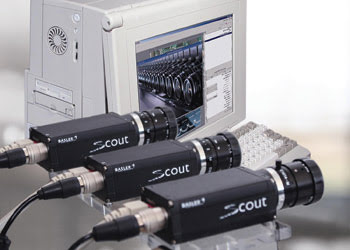Lossless data transmission results in a higher-quality product and increased production capability.
Henning Tiarks, Basler Vision Components
Paper and steel manufacturing pose a variety of challenges for inspection systems. Endless streams of material must be checked for flaws early on before the material is packaged, bundled or processed further. Material movement, surface texture and reflection are just a few of the constant challenges to camera systems.
A key player in the steel and paper inspection market uses up to 11 Scout cameras running simultaneously in its newest inspection system family. Each camera returns image data to software, where it is instantly processed for evaluation.
The Scout cameras, from Basler Vision Components in Ahrensburg, Germany, feature CCD sensors from Sony and CMOS sensors from Micron Technology of Boise, Idaho. In a test, the cameras were connected using new Gigabit Ethernet interface technologies that connect any number of cameras to PCs running software that allows for remote operation.

The digital Scout is a CCD-based Gigabit Ethernet camera that is used in a variety of applications, including inspection during paper and steel production.
In this operation, all cameras run at more than 200 frames per second while using the binning feature and are focused on different areas of interest. They are attached on one bar and aligned against each other so that they can scan all of the material, which is often more than 5 m wide. The material is illuminated by a parallel bar with high-performance LEDs. In these low-light conditions, the cameras must be very sensitive, even at high frame rates.
Bundles of three cameras are attached to a Gigabit Ethernet switch. From each switch, a single cable is attached to a rack-mounted PC equipped with Gigabit Ethernet ports and high-power CPUs to process the captured images. Image processing is primarily designed to detect and classify defects on the inspected material. In addition, conventional Ethernet ports on the PCs deliver the results to an operator in a remote location as far as several hundred meters away.
Previously, the same type of inspection was performed with analog cameras, but switching to digital cameras connected by Gigabit Ethernet increases the price-to-performance ratio. In this case, the total system cost was lowered by a two-digit percentage.
Each camera is equipped with internal memory for lossless data transmission. This buffering capability means that the PC can request that the camera resend missing image information. The mechanism is part of the camera’s firmware and driver and is automatically handled by each camera and pylon driver. Besides ensuring reliable transmission, the image memory also can store and transmit frames after a specified delay. This allows the user, for example, to grab an image simultaneously with all 11 cameras and to use delays to sequentially transmit image data from the cameras to a PC.
Before the design-in process began, the candidate cameras were exhaustively tested using two system layouts. The first system consisted of eight cameras attached to three PCs equipped with Basler’s pylon GigE Vision filter driver. Tests using this system configuration were run nonstop for 13 days without failures, dropped frames or hang-ups.
A second, more advanced layout consisted of three cameras attached to one computer that used two high-priority load generation threads to stress the system. With this configuration, several hundred million images were captured by the cameras, transported to the PC and processed, and no problems occurred during 19 days of nonstop running.
No images can be lost because, if there is a problem in the paper or steel, it might not be detected before the materials become part of the final product. Normally, defects in the material are marked so that a production planner can calculate their locations and avoid using the material accordingly. This results in less scrap material and increased production.
Meet the author
Henning Tiarks is a product manager at Basler Vision Components in Ahrensburg, Germany; e-mail: [email protected].